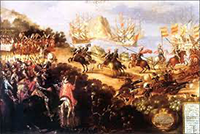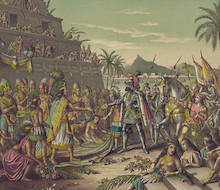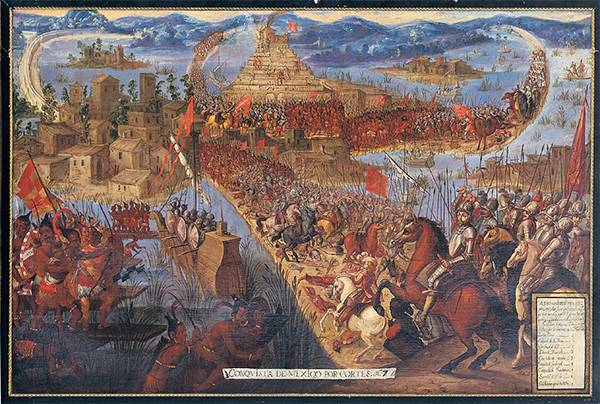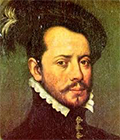The Conquest of the Aztecs
The Aztec civilization once ruled over much of Mesoamerica. It met its end by conquest, at the hands of a contingent of Spanish soldiers and disgruntled neighbors. Francisco Hernandez de Córdoba was the first European known to visit the Aztec civilization. He and a force of 100 Spaniards arrived, from Cuba, in 1517. After a brief tour of the area, he returned and convinced the governor there, Diego Velázquez, to send a larger force. After another expedition the following year, led by Juan de Grijalva, Spain agreed on a larger 
Cortés landed on what is now the southeastern coast of Mexico. He and his men founded a settlement that would become the city of Veracruz. Cortés, at one point getting wind of the desire of many of his men to return to Cuba, ordered the ships scuttled, stranding the Spanish force on land. After a period of intense training, Cortés and 400 soldiers marched into Aztec territory and found a willing ally in Tlaxcala, a neighboring city-state then at war with the Aztecs. Along the way, Cortés made friends with other city-states wishing to throw off the Aztec yoke, including Cempoala and Huejotzingo. Helping facilitate all of this alliance-making was an enslaved woman who could speak multiple languages. She was known to her people as La Malinche; the Spaniards called her Doña Marina. 
Cortés and his invaders arrived in Tenochtitlan, the Aztec capital, in November 1519. Moctezuma, the Aztec supreme ruler, welcomed Cortés as a friend, not the least because the light-skinned Spaniard bore more than a passing resemblance to the god Quetzalcoatl, whom legend said would return. The two leaders met officially on November 8. In a series of meetings, Cortés and his men caught glimpses of a treasure room filled with gold. This put many of them in mind of conquest. Cortés eventually gained the upper hand, convincing Moctezuma that the Spaniards' weapons more than made up for their deficit in number of warriors. Cortés and his men took Moctezuma and a number of other nobles hostage, and the Spaniards gained control of the capital city. Turning their guns and other weapons on the natives, Cortés and his men killed Moctezuma and thousands of others, beginning the Spanish conquest of the Aztec Empire. The resistance formed almost immediately, as Cuauhtemoc, a nephew of Moctezuma, took over as ruler, rallied the troops, and forced the Spaniards to retreat. Cortés went back to the alliance with Tlaxcala and returned at the head of a large joint invasion force. He didn't return right away. In between his appearances, a suite of European diseases that he and his men had brought with them wreaked havoc on the Aztecs, helpless against measles, mumps, and smallpox–none of which had appeared in that part of the world before. Some estimates are that in just the year 1520, imported diseases killed 40 percent of the population. In that same year, Cortés was busy fighting off an insurgency within his own ranks. The Cuban governor, Velasquez, had restricted Cortés's mission to exploration and trade because the governor himself wanted to be the conquistador who took over the mainland. In April 1520, Velázquez send a large number of Spanish troops under the command of Páfilo de Narváez to wrest command from Cortés and Cortés returned in May 1521. This time, he was aiming at conquest. On Aug. 13, 1521, Cuauhtemoc surrendered and the Spanish victory was complete. To cement his dominance, Cortés ordered another round of mass executions and then ordered Tenochtitlan burned to the ground. On its ashes he ordered built Mexico City. Any Aztecs who survived fled to nearby Tlatelolco. The rule of New Spain began. 
|
|
Social Studies for Kids
copyright 2002–2025
David White



 mission. The result was the expedition of
mission. The result was the expedition of  to kill him if necessary. Cortés left a contingent of soldiers in Tenochtitlan under the command of one of his lieutenants, Pedro de Alvardo (left). Cortés surprised Narváez's forces and destroyed them, then returned to Tenochtitlan, picking up more allies on the way. He first had to deal with the fallout from Alvarado's ordering an attack on Aztecs during a religious festival at the Temple Mayor. Cortés got his men out of the city, seeking refuge in Tlaxcala. It was during this time that smallpox hid Tenochtitlan hard, killing even the supreme ruler, Cuitlahuac. The former military ruler gave way to Moctezuma's nephew, and the stage was set for the final encounter.
to kill him if necessary. Cortés left a contingent of soldiers in Tenochtitlan under the command of one of his lieutenants, Pedro de Alvardo (left). Cortés surprised Narváez's forces and destroyed them, then returned to Tenochtitlan, picking up more allies on the way. He first had to deal with the fallout from Alvarado's ordering an attack on Aztecs during a religious festival at the Temple Mayor. Cortés got his men out of the city, seeking refuge in Tlaxcala. It was during this time that smallpox hid Tenochtitlan hard, killing even the supreme ruler, Cuitlahuac. The former military ruler gave way to Moctezuma's nephew, and the stage was set for the final encounter.
